If you are interested in seeing how I prepared the fabric and cut out the wool, etc., go and take a look at the Wool Tutorial I HERE.
Okay… so your layout is complete, your pieces are glued down and you are ready to stitch.
THREAD OR FLOSS CHOICE
I use matching thread [or at least in the same color family if matching is not possible] but am starting to get more comfortable with floss and I love the detail it adds.
… for this project, I am choosing to work with thread for the leaves because there is a lot of stitching and I don't want it to overwhelm the wool and as an accent, I am using coral floss for the blooms.
Of course I choose to work with our Farmhouse Aurifil sets, either thread or floss [let us know if you are still wanting to add these to your monthly shipments or if you are just interested in purchasing them even if you are not in the program]
Alternatively, you can use matching floss. In that case, take your floss and unwind it [standard floss has 6 strands of thread] and divide it into either 2 or 3 strand sections. A strand of 3 will clearly be a bit stronger and more visible than one of 2 but both are good choices so I highly recommend that you make a small practice shape and try both to see what you personally like… that is what I did!
… this is what it looks like when you separate the strands of floss.
I chose 2 strands for the coral blooms here below.
STITCHES
For the look that I prefer, I stick to the simple whipstitch. I aim for small straight stitches, app. ⅛” away from each other, ⅛” into the wool and always straight to the imaginary center of your piece [if on a circular piece] or just straight in [if on a straight edged piece]. What this means is that you always want your stitches to be straight into the middle of your applique and not at a slant [although you will tend toward that because it is just natural].
… shown here, stitches, turning with the shape to always be into the "imaginary center".
But please know…. I AM BY NO MEANS AN EXPERT STITCHER AND MY STITCHES ARE FAR FROM PERFECT. I am sharing them with you here so that you can see how I do it… even if quite imperfectly! I am sure that so many of you out there are expert stitchers so if you have tips or hints to share… please do!
Now I know that most traditional and primitive wool applique uses the traditional blanket stitch. This is a stitch that usually goes a bit further into the wool than I do and creates a rope-type border around the outside of your shape. I think this is beautiful and you can of course use this stitch if you like.
For me, it is a bit too primitive looking for what I am going for and a bit too time consuming. I prefer the more simple stitch but again would recommend that you try it out before you get started to see what you might find as your preference.
READY TO STITCH
Step 1: Cut a piece up to 18” long and knot your thread or floss and trim the end. Knotting the floss is fairly straightforward. Knotting the thread is generally the easiest to do if you do a "quilter's knot". For me… that has too many steps and takes too much time! I literally take the end of the thread in my fingertips, roll it around a bit and usually get a simple knot. I trim the end off if needed. I know some of you are probably gasping out there! Just being real LOL!
Step 2: To start, bring your needle upward from the back through both the fabric & the wool app. 1/8" into the wool… remember that where you bring this first stitch out will be the determining factor for all the rest… as you work to have all of your stitches even in size to this one.
You can poke up through the fabric several times if you need to in order to determine where you want the stitch. Pull your thread all the way through until you feel your knot catch and then make a straight stitch right into the background -right along the edge of your shape. For the next stitch, repeat from underneath, matching the placement so that the stitches are the same length. This is simply a basic straight whip stitch!
… first stitch into the wool already shown. Now placing the needle into the background exactly in the "same position" as the first stitch in order to create a small straight stitch.
… now coming back into the wool from underneath.
… and back again [shown drawn in white].
Step 3: Continue to stitch around your shape, knotting the thread underneath when done with the shape.
… the thread stitches more or less disappear into the wool itself, adding a small finished look.
… the floss stitches are more decorative and a bit stronger [shown here drawn in white]
… shown here actual [not as perfect as the drawing!]
… the difference of thread versus floss.
Step 4: Make sure your stitches are snug as you go along, but not tight and not loose.
Step 5: Knot threads in the back and leave a small tail.
Step 6: Gently press the block when you are finished and set aside somewhere flat.
INFO ON MACHINE STITCHING
If you want to mix hand and machine work, a small machine buttonhole also works quite nicely, making the process even more simple for those of you who are not avid hand appliquers. I use this method as well especially when I have long straight pieces, primarily stems [or the borders on our Woolies patterns] as I find that is the best place to utilize a machine.
Obviously you have to use thread on a spool and not floss for this type of stitching. Find something that resembles a buttonhole or blanket stitch. On my old, trusty Bernina, it’s stitch #26 and I adjust the width & length to mimic my hand stitches as much as I can. Most machines with a variety of stitches will have something like this.
Hope this helps! See you next time,
Joanna
About The Author
Joanna
Related Posts
WORKING WITH WOOL + NEW SPRING-INSPIRED PROJECTS
We’ve done a few wool tutorials here on the blog (dating back to…
March 28, 2024GUEST TUTORIAL: PATCHWORK EASTER EGGS
Hello everyone! I am Lacey Poirier (@laceypoirier on Instagram) and I am happy to be…
March 12, 2024
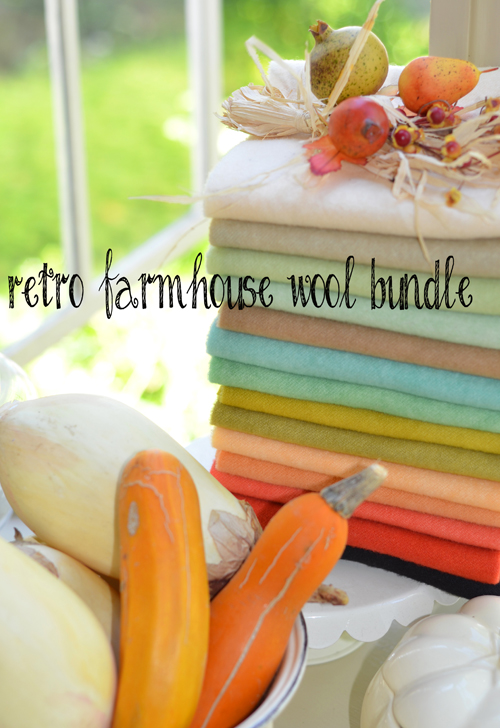


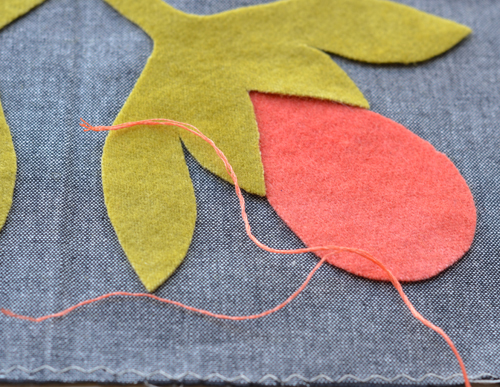

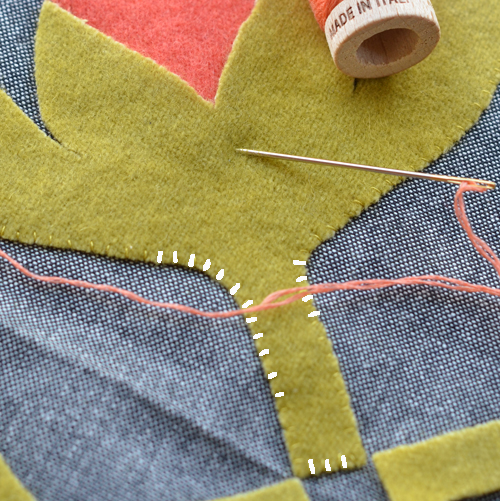
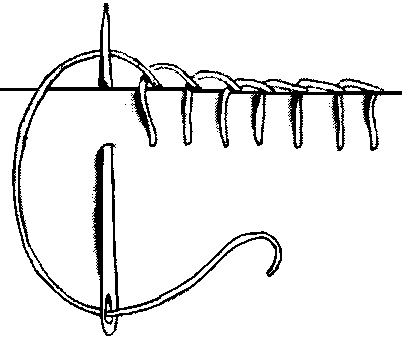
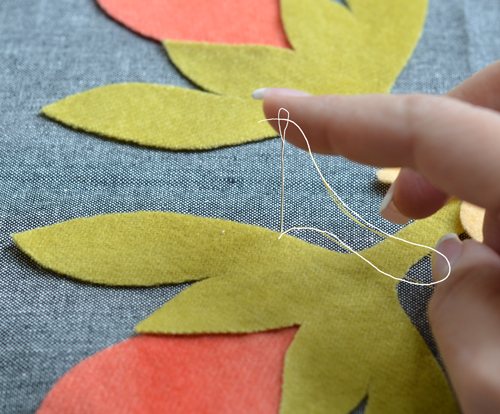
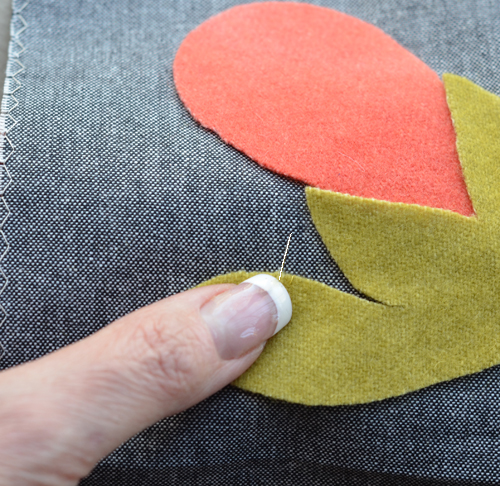
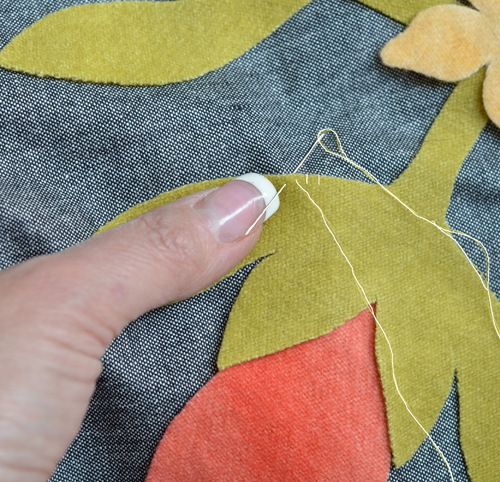

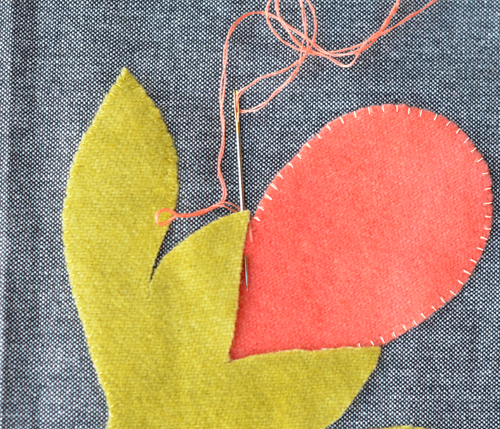
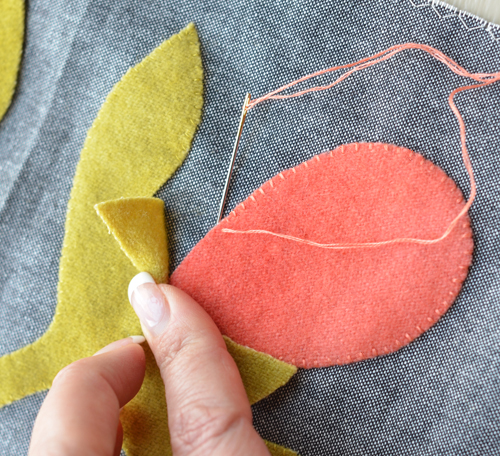
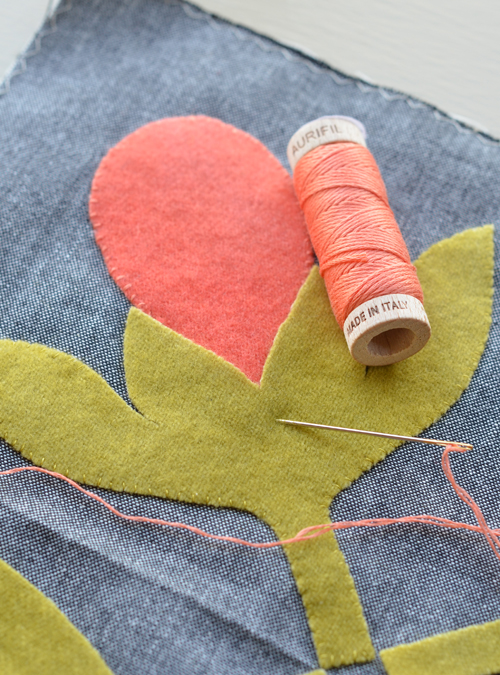

ferne | 17th Feb 16
Great tutorial! I can’t get the link to open to the first part though. I’ll probably find it, but thought you might want to know.
Peggy | 18th Feb 16
Glad to know someone ‘great ‘ in the quilt world makes a knot like me❣❣ I was making clothes long before I began quilting. So I saw no reason to make a quilters knot. I tried but yes
it is slower to me. Thanks for your beautiful fabric and patterns. But……..could you designers slow down so we can play catch up????????????????????????????
Karen Seitz | 18th Feb 16
I’d like to use perle coton for my applique stitching, but I am having trouble locating matching colors. I couldn’t find the Facebook page for the BOM to see if anyone had posted information on matching color numbers for perle coton, so maybe that isn’t up and running yet. If anyone has this information, I would really appreciate seeing it. Thanks!
Corie Greene | 18th Feb 16
Great tutorial…super pictures that make it easy to follow…
thank you!
Joanna | 21st Feb 16
Ha, ha, ha! Thanks for your comment! Slowing down sounds good to me too… but the design world just keeps going! LOL
Joanna | 21st Feb 16
Unfortunately I don’t have any info on perle cotton but perhaps others do?
Karen Seitz | 23rd Feb 16
Hope so! I have a mix of Finca (Prescencia), Valdani, and DMC so far, but I still need about 7 more of the colors. Those yellow greens are troublesome to match so far.
Sunny | 1st Mar 16
Knock threads in the back look extremely neat. We at jetessay.com believe the piece is a great success!
Karen | 2nd Mar 16
Joanna, am I the only one having difficulties with your wool BOM? Firts: You praise Weeks Dye Works, however my wool appears blotchy. Is that the look we are going for? Second: you stated you would post a photo of block one stitched back on January 24thish. I still have not located that photo. Third: I just completed my first crossweave/cream block. Your cutting measurements didn’t have the cream corners touching so I adjusted the crossweave fabric so my block would match your illustration. My finished block is only 10″!! With no photos to compare to I don’t know if the cut sizes are wrong, the finished square measurement is off, or if I am not understanding the directions. Please help!
Joanna | 2nd Mar 16
Hello Karen-
To answer all of your questions:
1- Yes, the wool is hand dyed and so has variegations and different tones in each piece. It is part of what makes it so beautiful in our opinion. It gives the wool depth and a handmade feel. We love it for precisely that reason!
1- There have been dozens of photos posted of finished blocks all over Instagram and Facebook so we did not also post ours. Just search for #figtreewools or #retroFarmhousewoolbom. We showed what our block looked like on the first blog tutorial so everyone could see placement and anything else they needed in order to do theirs. We didnt think more photos were needed. We will post more updates again later this month, probably after the second block has been fully stitched down.
3- The instructions do have all of the corners touching. It sounds like perhaps your seams are a tiny bit too big or too small. There are no adjustments needed. The instructions and the diagram in the pattern is all that you need to finish those blocks.
Hope that helps and good luck!
Joanna